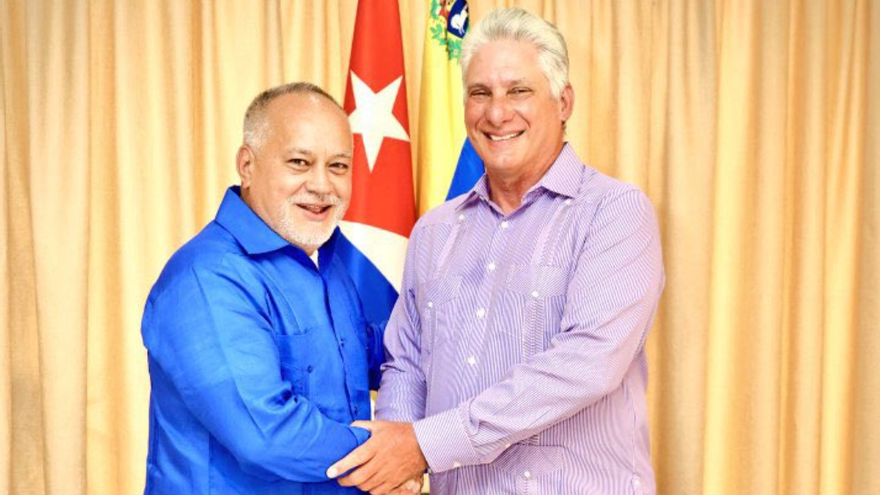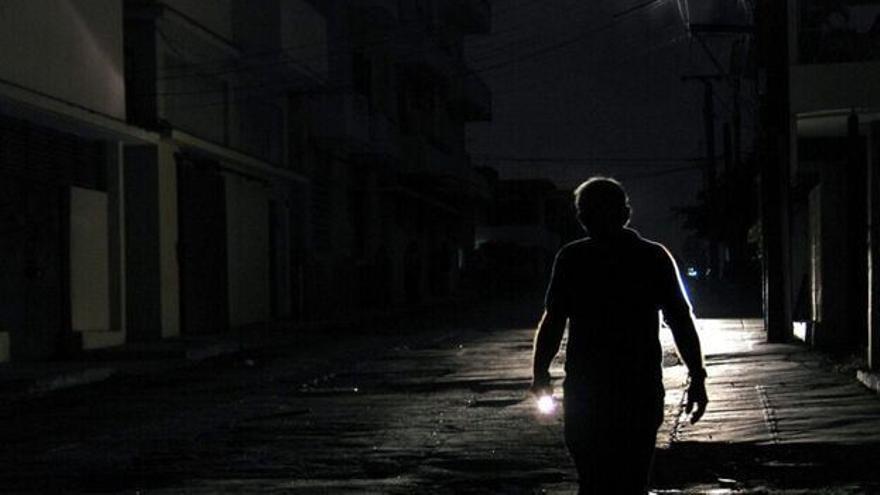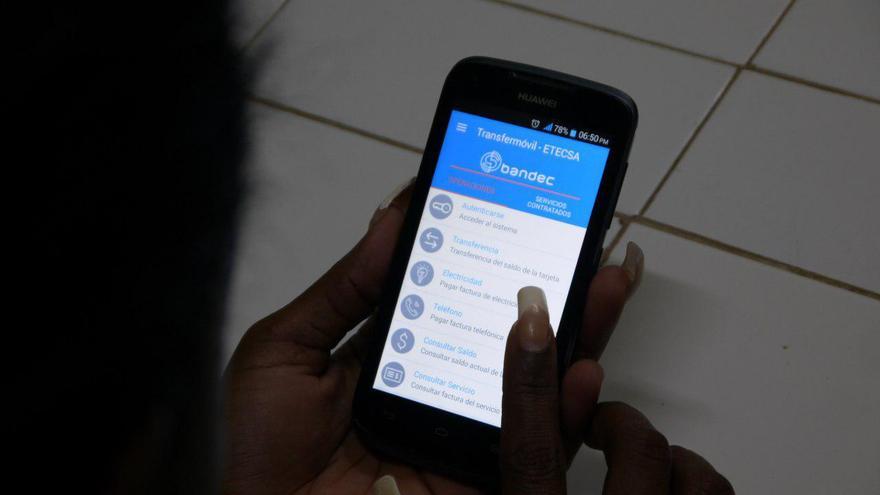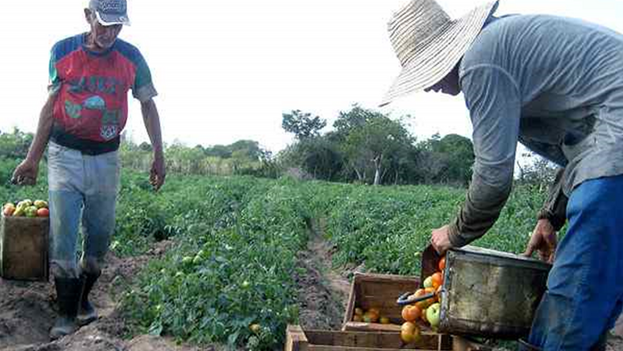Lídice Crespo, a 32-year-old woman, arrived at the Ramón González Coro Hospital in Havana on September 20, 2022. She was in the 38th week of her pregnancy, about to give birth to her first child, and she had many questions. How should she push? What would the hospital’s protocols be? Was someone going to explain how to breastfeed the baby?
The answers to these questions should have been received during the six psychoprophylaxis sessions that, in theory, pregnant women start having at week 34.
However, Lídice, like so many other women, did not receive any preparation for childbirth.
Full of fear, but excited about seeing her baby, she entered the preparation salon around 10 in the morning. There, in a room she shared with other pregnant women, they gave her a gown and asked her some routine questions, such as her blood type.
Although her water had not yet broken and she hadn’t expelled the mucous plug that protects the uterus during pregnancy, two signs that birth is imminent, she was hooked up to a bag of oxytocin, the hormone that accelerates childbirth. It was the first of a total of five bags that were administered in the next 24 hours.
While she was waiting, she was not allowed to eat anything. “That day I didn’t eat any food, just a cookie. I even asked them to get me the food that my family brought and they didn’t do it,” says Lídice. She could only drink. They didn’t allow her to be accompanied either. She would have liked to have been with her husband. “I was alone there. I had to depend on what they wanted to do to me,” she says. continue reading
At dawn, she was exhausted and in pain as a result of the contractions and multiple vaginal touches from medical students. Then she began to despair. “When I couldn’t do it anymore and saw that my baby wasn’t coming out, I requested a cesarean section. At that moment a doctor passed by and spoke loudly to me, and without any sensitivity told me that I was the one who had decided to get pregnant so I had to handle the pain myself and take deep breaths,” she says.
Lídice urinated and defecated on herself. She begged for a new gown and was denied. Thanks to a student who interceded, they finally offered her clean clothes. In the morning, she was taken to the delivery room in a wheelchair. Nobody told her that she could choose the position to give birth, that she could do it standing up if it was easier. They only ordered her to lie down and push.
“In the salon they performed a Kristeller’s maneuver on me (pressing the abdomen to push the fetus). After each maneuver I suffered immediately. It was hell. Finally, at 9:28 am on the 21st, the love of my life was born. They didn’t let me touch him, or see him. The boy was taken away immediately,” says Lídice.
Then, while pushing to expel the placenta, she felt a very intense pain in her ovaries and began to bleed. The young mother suffered a serious hemorrhage that required emergency surgery to remove the uterus. However, no one explained to her what was happening or why.
In theory, none of this should have happened.
Almost two months before Lídice gave birth, the authorities of the Ministry of Public Health (MINSAP) published a guide or recommended practices
Almost two months before Lídice gave birth, the authorities of the Ministry of Public Health (MINSAP) published a guide that establishes which practices are recommended in childbirth and which constitute forms of what is called “obstetric violence.”
In addition, on the same dates, at the beginning of August 2022, the MINSAP announced that the new recommendations on respectful childbirth would begin to be applied in a pilot project that would be developed precisely at the González Coro hospital, where Lídice gave birth, and in other health centers. However, practically none of the recommendations established in the guide were complied with in the childbirth that Lídice experienced.
Lídice should have received six sessions of preparation for childbirth to understand everything that was going to happen to her. They should have allowed her to be accompanied and to eat something light, if she wanted to. They should have encouraged her to give birth in a vertical position or at least inform her that there was such a possibility.
They shouldn’t have begun to induce childbirth with oxytocin at such an early stage and should have allowed her to take the necessary time to dilate. They should never have practiced Kristeller’s maneuver or immediately separated her from her baby. At all times, she should have been informed of what was happening to her.
All these recommendations are part of the guide published by the authorities, which, in theory, the health professionals of the González Coro hospital, among the hospitals that enjoy the best reputation in Havana, must have known and should have applied. None of that took place, and Lídice’s case is not an isolated one.
The visibility of obstetric violence in Cuba by independent journalists, activists and academics contributed to last year’s announcement by the State that it was trying to change this phenomenon.
Thus, they promised that Cuba would begin to apply the standards of respectful childbirth that are already common in other countries and promoted by the World Health Organization (WHO). However, after interviewing six mothers who recently gave birth at the González Coro and health personnel who work in this and other hospitals, it was found that the official promises are far from being fulfilled.
According to the sources consulted, the guide that aimed to reform childbirth care is not really mandatory but a “consultation document
According to the sources consulted, the guide that aimed to reform childbirth care is not really mandatory but a “consultation document,” with recommendations that professionals can ignore. The pilot plan to apply the guide consisted of a series of talks in which professionals in the sector were informed of its existence.
Women like Lídice, who gave birth in hospitals where the pilot plan was applied, told of traumatic childbirth experiences, very similar to those that hundreds of mothers from all over the country had reported in the Partos Rotos project. None of the main practices of respectful childbirth were applied when they gave birth.
These findings highlight the weakness of the Cuban strategy to confront obstetric violence, a global phenomenon that many countries are trying to combat. Experts from Spain, Bolivia and Argentina consulted for this report pointed out that in order to be successful, multiple measures must be applied at the same time; for example, the promotion of laws that establish the right to a respectful childbirth, the creation of observatories on obstetric violence and the dissemination of statistics that make the problem visible and allow monitoring of its evolution.
The specialists also agreed on the need for countries to involve civil society, especially women’s movements, professional associations, scientific societies and patient associations.
Cuba, an authoritarian country in which civil society is ignored or persecuted and where the only health statistics that are disseminated are usually those that confirm the success of its health system, is not doing any of this. About 270 pregnant women continue to give birth every day in a system that, as the authorities themselves now recognize in the new guide, violates and harms women and babies.
The Guide and the Pilot plan
In recent years, obstetric violence has gained visibility in Cuba. Several academics have focused their research on this problem. On social networks, the testimonies of pregnant women who reported mistreatment, bad medical practices or lack of empathy during their deliveries, which caused them physical and psychological damage, have multiplied. The topic has also been the focus of attention of independent journalism projects like this one.
A year ago, we published research that shows how obstetric violence in Cuba is systemic. Through a survey, we collected information about 514 births. The women told us how they felt and what kind of medical practices were carried out when they gave birth.
The panorama they offered was that of a medical system in which the pregnant woman is considered a passive subject who should only obey orders and whose well-being is rarely taken into account.
They also reported how in Cuba there are practices that are in disuse in other countries: women are prohibited from being accompanied, eating or barely moving; episiotomy is abused, (a cut in the perineum to facilitate childbirth) without even informing pregnant women that it will be done; manual dilation of the cervix and Kristeller’s maneuvers are also used to speed up the time of natural childbirth.
After the publication of the research, the State appeared to react. In the official press, especially in the provincial media, articles addressing the subject began to appear. Leaving the official line of propaganda, which usually portrays Cuba as a medical power and the professionals of the system’s health system as heroes, media such as Periódico 26 de Las Tunas published articles in which it was recognized that childbirth could involve violence and trauma.
In these publications, something essential was ignored: many of the practices considered obstetric violence do not happen because of the initiative of doctors or because of their lack of empathy or knowledge. That is, they are not a breach of the rules, but rather they are in compliance with the strict protocols of childbirth care that exist in the country’s hospitals.
Many of the practices considered obstetric violence do not happen because of the initiative of doctors or because of their lack of empathy or knowledge
But, even so, the existence of obstetric violence was recognized, and this term was openly used, something new in the official discourse (EcuRed, the Cuban wikipedia, incorporated the concept in 2021).
In some cases, it was also announced that the health system was already working on the problem and that it was a priority issue. The Sancti Spíritus newspaper, Escambray, even went so far as to report that the country was already at the forefront of the world in the fight for respectful childbirth.
In parallel with these publications, on August 4, 2022, the authorities presented the so-called Action Guide for the care of respectful childbirth. In this official document, for the first time, it was admitted that an excessively medicalized approach to childbirth prevails in the country and that this prioritizes the needs of doctors over the well-being of pregnant women and their babies.
The guide is the result of collaboration between national specialists and the the United Nations Population Fund (UNFPA), headquartered in Cuba. This UN organization has been a pioneer in introducing the problem of obstetric violence to the country. Already in 2018, it organized the first workshop on respectful childbirth that was given to officials from MINSAP and to health personnel.
The document recognizes the magnitude of the problem and also establishes a series of recommendations. The goal is for pregnant women to be the true protagonists of their childbirth, to be respected and listened to.
The guide also advises or asks that practices that are common in hospitals, which are considered manifestations of obstetric violence, be minimized. Basically, the document proposes a childbirth protocol opposite to the existing one.
It insists on the need for psychoprophylaxis sessions to be fulfilled. It introduces the idea that women make a childbirth plan in which they explain how they want their time giving birth to be, what they want to happen and what they don’t, something that is already common in some countries.
The document also asks that women be allowed to be accompanied, to eat, move, push in the position they want and to be in contact with their babies after birth. In addition, it advises limiting as much as possible the practices that are now applied almost universally, such as episiotomy or the Kristeller’s maneuver.
The guide is aimed at professionals who are part of childbirth care throughout the country and insists that its recommendations be taken into account
The guide is aimed at professionals who are part of childbirth care throughout the country and insists that its recommendations be taken into account. At the same time, the document is careful not to present its recommendations as mandatory.
However, since its existence was announced, the authorities seemed to show a willingness for the guide to be applied in the real world. In fact, as part of the same project developed with UNFPA, MINSAP launched a pilot plan at the beginning of August 2022, which would consist of starting to apply the recommendations of the guide in a series of hospitals.
First, as announced, the pilot plan would be executed at the González Coro Hopsital in Havana and at the Camilo Cienfuegos Hospital in the provincial capital of Sancti Spíritus, between August and November 2022. Then, as early as 2023, the plan would be extended to six other centers, although it was never specified which ones.
In addition to the hospitals, the pilot plan also included the polyclinics that depend on them. As explained, their participation would be key to carrying out the childbirth sessions and to encourage pregnant women to make birth plans.
The little official information available about this plan describes the pilot as a program to train staff on how to apply the new childbirth care practices. It also explained that the “research action” methodology would be followed. This is a common form of research in Cuban medical science, which involves working on a problem where it occurs. The goal is to know the reality at the same time as it is transformed.
The provincial press of Sancti Spíritus even said in an article published in December 2022, that the pilot plan had been applied in real births. They specified that, for the first time, pregnant women were allowed to give birth accompanied.
The effective application of the guide also contributed to the announcement that the pilot plan would have a series of indicators that would be monitored, and that once concluded in the first hospitals, a report would be presented to evaluate the experience.
The Reality
However, since these announcements were made with great fanfare a year ago, neither the official press nor the State institutions have referred again to the guide, the pilot plan, or the concept of respectful childbirth.
For this report, we depend on UNFPA’s point of view on how the experience of starting to change such deep-rooted medical practices is turning out. In an email, the UN institution said that they could not offer statements without authorization from MINSAP. When we requested permission from the Ministry, we never received a response. We also tried to contact by mail and networks the professionals from Cuba who created the guide, but no one responded.
However, González Coro professionals did describe in some interviews what the pilot plan really was like and its limited scope. An OB-GYN with more than ten years of experience attending deliveries in the hospital confirmed that there is currently no trace of a pilot plan nor use of the new guide.
According to this professional, who like all those consulted asked not to be identified for fear of reprisals, efforts to reduce obstetric violence were reduced to a series of meetings. There was no implementation of the new protocols, no indicators, no evaluation.
“They met with the doctors, made (the guide) known and it was all over. In this hospital (González Coro) no pilot plan is being implemented in practice, nor was it ever implemented,” the doctor said.
Two other nurses linked to obstetrics in the same center confirmed that they never observed a change in childbirth care protocols. One of them, despite working in the postpartum salons, even said that she did not understand the concept of respectful or humanized childbirth, nor was she aware of the existence of a new guide to treat pregnant women.
We tried to interview professionals who work in the other hospital where, according to the published information, the pilot plan was implemented, the Camilo Cienfuegos of Sancti Spíritus, but it was impossible to find anyone willing to talk.
In other hospitals in the country, which could be among the additional six in which the pilot plan has been implemented, a similar version of what happened at the González Coro was obtained: a meeting to report on the guide and no specific changes in childbirth care.
An OB-GYN from the Abel Santamaría hospital in the provincial capital of Pinar del Río explained that, at the beginning of May 2023, the hospital management gathered the specialists of the maternal and children’s wing of the hospital and explained to them the new procedures introduced by the guide.
“They only summarized the document for the group so we could know it existed. No one gave an opinion. We all knew that it was not going to be implemented and that we only had to comply with knowing about the text,” said this doctor.
As she explained, in that session the nursing staff was not even invited, which is key in the care of pregnant women, so she deduced that the intention of the hospital management was never to really apply the new model. “The humanized childbirth guide exists, is known and will not be implemented,” said this professional.
The Mothers’ Experiences
This version offered by health personnel is consistent with what we were told by women who gave birth at the González Coro hospital in the last months of 2022 and the first months of 2023.
Partos Rotos designed a short survey with 15 questions about the key changes recommended by the guide.
Some questions refer to basic issues of well-being. For example, we asked if mothers were able to choose the position for giving birth, if they were allowed to walk freely, to be accompanied during childbirth or to hold their baby at birth.
We also asked about other recommendations related to excessive medicalization of childbirth, such as the use of oxytocin at the right time or episiotomy.
Six women answered the questionnaire. Although all the questions could be answered as yes or no, we also interviewed the women in more depth. They all offered a very similar childbirth experience, in which the basic standards of respectful childbirth were not met.
Only on the question about whether they were allowed to walk during dilation, did they all answer yes. But they also all said that they were not encouraged to do so, unlike the guide’s recommendation.
They all suffered either manual dilation by the so-called tourniquet, the Kristeller’s maneuver or episiotomy. Some suffered all these practices, which contributed to unnecessarily painful births. The women reported that even the simplest recommendations were ignored.
The vaginal touches can be painful and most women consider them uncomfortable or annoying. In addition, especially in long births, they can increase the risk of infection
For example, the new guide limits the number of vaginal touches that should be performed on pregnant women to one every four hours (more than that is considered unnecessary in most cases) and recommends that they always be performed by the same person.
The vaginal touches can be painful and most women consider them uncomfortable or annoying. In addition, especially in long births, they can increase the risk of infection. In Cuba, infections during the postpartum period are one of the main causes of maternal mortality.
Despite this, it is common for Cuban professionals to routinely perform vaginal touches every two hours or less, even if childbirth has not evolved, or to ask medical students to do them for learning purposes.
It’s just the change of a professional habit, but with their answers, the mothers showed that even this type of improvement is far from being applied. Half of the respondents said that they were touched at least once every hour, and they all agreed that this was done by more than one person.
All the questions that refer to the availability of a new resource recommended by the guide, such as gowns that allow breastfeeding without having to undress, the use of balls for sitting to relieve pain or some type of installation that allows vertical birth, were answered negatively by all the respondents.
“I saw none of that” or “that doesn’t exist,” the mothers said. The same thing happened with the question about being accompanied. They all said that they were not allowed to have their partner or a family member around. This, according to González Coro staff, is a privilege that is only sometimes granted. “Since 2017 or 2018, we had been told that parents could be allowed at the time of delivery, but this was never put into action in a general way. Only in some cases of friends. Today the pregnant women are still alone,” confessed an obstetrician from this center.
The International Experience
The limited Cuban approach to obstetric violence of creating a guide and disseminating it among some professionals contrasts with the one adopted in other countries. Spain, for example, has undertaken a strategy with multiple measures, according to Rosario Quintana, a respected gynecological expert in childbirth, who directed the public health services of the Cantabria region, in the north of the country.
Quintana explained that the first thing was to try to create a new consensus in the medical system on the need for all the practices carried out in childbirth to be based “on the best available scientific evidence” and to put the mother at the center.
That is, in Spain a specific document was not created to define a respectful childbirth that interested people can use, as Cuba has done. They worked directly on updating how all births are handled. The intention was to eliminate all practices whose benefits are not scientifically proven – for example, doing continuous vaginal touches or indiscriminate episiotomy – or those which evidence shows should be avoided, such as separating babies from mothers at birth.
In this work, the expert explained, different actors in the health system participated, as well as women’s movements such as El Parto es Nuestro [It’s Our Childbirth], researchers and patient associations.
The result was a document called “Normal Birth Strategy” that then began to be disseminated, among others, by a Women’s Health Observatory, created a few years earlier.
This, Quintana explained, triggered great interest in the subject. Workshops and conferences were organized, and the authorities presented more documents to guide health system professionals.
More recently, a law was passed that establishes respectful childbirth as a right.
Quintana stressed that, since obstetric violence is partly a cultural problem that involves the whole of society, it is essential to involve all sectors in the solution to the problem.
“I think it’s very important to have a women’s movement organized around pregnancy and respectful childbirth, with good training in evidence-based medicine. And the health authorities should be forced to initiate these changes,” Quintana said.
In other Latin American countries, a similar approach has also been adopted with the approval of laws on respectful childbirth and the publication of statistics that allow observation of the evolution of certain indicators, such as the percentage of cesarean sections or the creation of observatories on obstetric violence.
Ana Lía Bertoldi, an Argentine doula (a specialist in accompanying childbirth) who is part of the Observatory of Obstetric Violence of Bolivia, said that there are three necessary requirements to combat this problem. First of all, statistics: collect and publish data that show the problem and make it visible. Second, the approval of a respectful childbirth law that takes into account the needs of all women of any race, urban or rural. And finally, promote a cultural change by training health personnel and preparing mothers.
Bertoldi shared a success story about this in Argentina: that of the Estela de Carlotto Maternity, a public hospital in Buenos Aires, which has made advances in respectful childbirth.
“The doctors there say that the progress has not been because of laws, large infrastructures or large investments, but because of a cultural change. It’s not about doing some workshops and leaving it at that. It’s about forming a team determined to make that change from within. A decision from the board is important, and then a lot of horizontal work in the team and also with the mothers, who are sometimes not prepared,” Bertoldi said.
Resistance
This cultural change and the rejection that can arise among health professionals is one of the main problems faced by health systems to change childbirth care, explained the Spanish expert, Quintana.
“(Doctors) have been trained in a pathology model. They believe in the superiority of technological childbirth. And, of course, they feel totally authorized to act for the protection of the fetus by passing over the desires of the women,” Quintana explained.
The Cuban professionals interviewed for this report expressed their rejection of the practices of respectful childbirth or made it clear that, in their opinion, any change in Cuba is unfeasible.
For many of them, their job is to preserve the life of the mother and the baby. Any other consideration not only occupies a secondary place but can represent an obstacle to their work.
Some of these professionals consider respectful childbirth to be typical of rich countries, which can build new hospitals where mothers have calm and privacy, or bathtubs to give birth in water.
Some of these professionals consider respectful childbirth to be typical of rich countries, which can build new hospitals where mothers have calm and privacy
In this way, they tend to overlook that respectful childbirth, in reality, consists of a wide variety of practices, many of which are feasible in Cuba.
One of the doctors interviewed at Abel Santamaría, for example, argued that the new guide cannot be applied because those who wrote it did not take into account the precariousness in which they work.
“Those separate rooms that they mention (in the guide) with CTG (equipment to monitor the fetus) for each patient do not exist,” she said. She questioned how changes can be promoted in childbirth protocols when they face a shortage of such basic things as gloves and sutures. The doctor mentioned that they cannot do all the cesarean sections that are required due to lack of supplies. Also, they do not have the specific suture for episiotomies and are forced to sew with generic thread. This, as she said, harms the healing. “You have to ’invent’ with what there is,” she concluded.
“In this country many things are done to follow the world practices, to pretend that we are on a par with the advances, but everything is fictitious. They put anything they want on paper and don’t concentrate on the real conditions. Here we will never be able to do what the guide says if we continue as we are, and we are going from bad to worse,” said the OB-GYN at Abel Santamaría, from Pinar del Río.
To the problems she mentions, which in her opinion hinder the implementation of respectful childbirth in the country, are added the conditions in which they work, according to the testimony of other professionals consulted.
When we asked them why a woman is not allowed to be accompanied, some professionals argued, vaguely, that it is not possible because the rooms do not have the required conditions
In her opinion, waiting for the dilation to occur naturally or allowing the new mother to have at least 50 minutes to be in direct contact with her baby (as the guide establishes), are luxuries that they cannot afford. They simply don’t have that time because they need to attend to the next birth.
“We have days where it’s one birth after another. There is neither the space nor the number of specialists needed,” said the OB-GYN at González Coro. However, when addressing an issue such as the possibility of pregnant women being accompanied while giving birth, the staff explained that the obstacles faced in Cuba are not only from a lack of resources.
When we asked them why a woman is not allowed to be accompanied, some professionals argued, vaguely, that it is not possible because the rooms do not have the required conditions. But others openly admitted that it is easier for them if the pregnant women are alone.
“The patients and their families are very undisciplined and don’t follow the rules,” said one of the nurses interviewed at the González Coro hospital. “Women who give birth get very spoiled, and if they have a companion they don’t let us work,” said a doctor from the Abel Santamaría hospital in Pinar del Río.
Another Cycle
Although the new guide and the creation of the pilot plan are the most public efforts made so far in Cuba to reduce obstetric violence, they have not been the first.
For more than 15 years, a regulation has been in force that encourages low-risk vaginal deliveries – which are the majority – to be attended mainly by specialized nursing staff. This is provided in Ministerial Resolution 396-2007.
The idea behind this rule was to demedicalize childbirth, give greater prominence to nursing staff, whose area of knowledge is care and well-being, and limit the intervention of the doctors to what is essential.
This would reduce the cascade effect that happens in many births, in which medical intervention leads to situations that can only be resolved, precisely, with more medical intervention.
The resolution promised great changes; however, it has barely been applied. Partos Rotos has surveyed hundreds of pregnant women who have given birth in Cuba since this rule came into force in 2007, and all were treated by doctors. The supremacy of the OB-GYN in the delivery room seems unquestionable, and Resolution 396-2007 is an old forgotten document.
Now history repeats itself. With the publication of the new guide for childbirth care, a period of reform in the health system was opened, such as the one promised by the Resolution. But as happened with the resolution, everything seems to have been left on paper.
Translated by Regina Anavy
____________
COLLABORATE WITH OUR WORK: The 14ymedio team is committed to practicing serious journalism that reflects Cuba’s reality in all its depth. Thank you for joining us on this long journey. We invite you to continue supporting us by becoming a member of 14ymedio now. Together we can continue transforming journalism in Cuba.
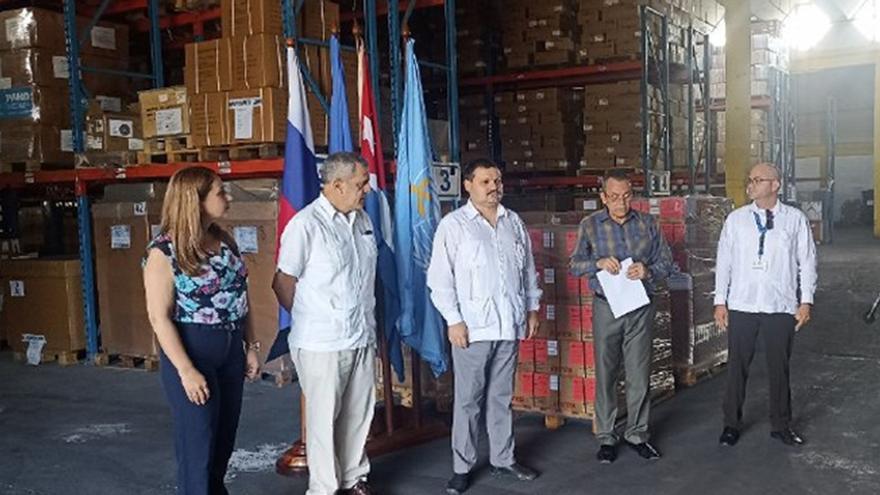
![]() 14ymedio, Havana, 16 August 2023 — Some 26 tons of medicines and medical equipment purchased with Russian funding were received this Wednesday in Havana by the authorities of the Ministry of Public Health. Moscow bought the supplies from the World Health Organization (WHO), and its diplomats on the Island attended a “thank you” ceremony in medical supply warehouses in Havana.
14ymedio, Havana, 16 August 2023 — Some 26 tons of medicines and medical equipment purchased with Russian funding were received this Wednesday in Havana by the authorities of the Ministry of Public Health. Moscow bought the supplies from the World Health Organization (WHO), and its diplomats on the Island attended a “thank you” ceremony in medical supply warehouses in Havana.
